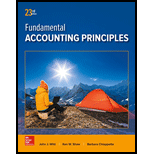
Concept explainers
Journal entry is a way of recording the financial transaction of the company related to certain dates that shows chronological effect in the books of accounts. Journal entries are recorded on the basis of dual aspect accounting method.
Accounting Rules for Journal Entries:
⮚ To increase balance of the account: Debit assets, expenses, losses and credit all liabilities, capital, revenue and gains.
⮚ To decrease balance of the account: Credit assets, expenses, losses and debit all liabilities, capital, revenue and gains.
Assets Disposal:
Assets when disposed off may be beneficial for the company which is totally depends on the book value of the assets. If disposal amount is greater than book value there would be profit otherwise loss to the company.
To prepare: journal entry to record the partial year’s
Want to see the full answer?
Check out a sample textbook solution
Chapter 10 Solutions
Fundamental Accounting Principles
- I am looking for the correct answer to this financial accounting question with appropriate explanations.arrow_forwardPlease help me solve this general accounting problem with the correct financial process.arrow_forwardCan you help me solve this general accounting question using the correct accounting procedures?arrow_forward
- Given the following information, what is the gross margin percentage? • . • • Sales $620,000 Sales Discounts = $12,000 Sales Returns and Allowances = $28,000 Cost of Goods Sold (COGS) = $350,000 a) 36% b) 40% c) 42% d) 45%arrow_forwardPlease provide the solution to this financial accounting question with accurate financial calculations.arrow_forwardPlease given correct answer for financial accounting question I need step by step explanationarrow_forward

 AccountingAccountingISBN:9781337272094Author:WARREN, Carl S., Reeve, James M., Duchac, Jonathan E.Publisher:Cengage Learning,
AccountingAccountingISBN:9781337272094Author:WARREN, Carl S., Reeve, James M., Duchac, Jonathan E.Publisher:Cengage Learning, Accounting Information SystemsAccountingISBN:9781337619202Author:Hall, James A.Publisher:Cengage Learning,
Accounting Information SystemsAccountingISBN:9781337619202Author:Hall, James A.Publisher:Cengage Learning, Horngren's Cost Accounting: A Managerial Emphasis...AccountingISBN:9780134475585Author:Srikant M. Datar, Madhav V. RajanPublisher:PEARSON
Horngren's Cost Accounting: A Managerial Emphasis...AccountingISBN:9780134475585Author:Srikant M. Datar, Madhav V. RajanPublisher:PEARSON Intermediate AccountingAccountingISBN:9781259722660Author:J. David Spiceland, Mark W. Nelson, Wayne M ThomasPublisher:McGraw-Hill Education
Intermediate AccountingAccountingISBN:9781259722660Author:J. David Spiceland, Mark W. Nelson, Wayne M ThomasPublisher:McGraw-Hill Education Financial and Managerial AccountingAccountingISBN:9781259726705Author:John J Wild, Ken W. Shaw, Barbara Chiappetta Fundamental Accounting PrinciplesPublisher:McGraw-Hill Education
Financial and Managerial AccountingAccountingISBN:9781259726705Author:John J Wild, Ken W. Shaw, Barbara Chiappetta Fundamental Accounting PrinciplesPublisher:McGraw-Hill Education





